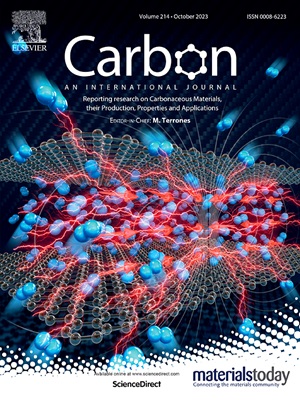有机溶剂运输通过还原氧化石墨烯膜与控制氧含量
IF 11.6
2区 材料科学
Q1 CHEMISTRY, PHYSICAL
引用次数: 0
摘要
基于二维(2D)材料的膜的最新进展使精确控制埃级孔隙成为可能,为研究各种质量传递机制提供了独特的平台。在这项工作中,我们系统地研究了溶剂蒸汽通过由氧化石墨烯(GO)层压板制成的二维通道的传输,并精确控制氧含量。利用维生素C对氧化石墨烯进行原位化学还原,我们制备了氧化石墨烯还原膜(VRGMs),其氧含量从31.6%(原始氧化石墨烯)系统地降低到24.0% (vrgm -最大还原)。水蒸气渗透性测量表明氧官能团与溶剂运输行为之间存在明显的相关性。具体来说,非极性己烷通过石墨畴较大的还原膜的渗透率提高了114%,而水的渗透率降低了55%。在密度泛函理论(DFT)的支持下,我们模拟了溶剂与氧化石墨烯之间的氢键和分散配合物,并计算了配合能。模拟结果表明,极性分子通过氢键网络与氧化石墨烯的氧官能团相互作用,支持平面内传输。相反,在还原氧化石墨烯膜中,范德瓦尔斯力驱动低极性溶剂沿着二维通道的石墨畴传输。我们的发现为未来有机溶剂纳滤膜的设计提供了潜在的策略。本文章由计算机程序翻译,如有差异,请以英文原文为准。

Organic solvent transport through reduced graphene oxide membranes with controlled oxygen content
Recent advances in membranes based on 2-dimensional (2D) materials have enabled precise control over angstrom-scale pores, providing a unique platform for studying diverse mass transport mechanisms. In this work, we systematically investigate the transport of solvent vapors through 2D channels made of graphene oxide (GO) laminates with precisely controlled oxygen content. Using in-situ chemical reduction of GO with vitamin C, we fabricated reduced GO membranes (VRGMs) with oxygen content systematically decreased from 31.6 % (pristine GO) to 24.0 % (VRGM-maximum reduction). Vapor permeability measurements showed a distinct correlation between oxygen functional groups and solvent transport behaviour. Specifically, non-polar hexane exhibits 114 % of enhanced permeance through the reduced membranes with larger graphitic domains, while the permeance of water decreases by 55 %. With the support of density functional theory (DFT) simulations, we modelled the hydrogen-bond and dispersion complexes between the solvents and GO and calculated the complexation energies. The simulation results suggest that polar molecules interact with the oxygen functional groups of GO via a hydrogen-bond network, supporting in-plane transport. In contrast, van der Waals forces drive the transport of low-polarity solvents along the graphitic domains of the 2D channel in reduced GO membranes. Our findings provide potential strategies for future design of organic solvent nanofiltration membranes.
求助全文
通过发布文献求助,成功后即可免费获取论文全文。
去求助
来源期刊

Carbon
工程技术-材料科学:综合
CiteScore
20.80
自引率
7.30%
发文量
0
审稿时长
23 days
期刊介绍:
The journal Carbon is an international multidisciplinary forum for communicating scientific advances in the field of carbon materials. It reports new findings related to the formation, structure, properties, behaviors, and technological applications of carbons. Carbons are a broad class of ordered or disordered solid phases composed primarily of elemental carbon, including but not limited to carbon black, carbon fibers and filaments, carbon nanotubes, diamond and diamond-like carbon, fullerenes, glassy carbon, graphite, graphene, graphene-oxide, porous carbons, pyrolytic carbon, and other sp2 and non-sp2 hybridized carbon systems. Carbon is the companion title to the open access journal Carbon Trends. Relevant application areas for carbon materials include biology and medicine, catalysis, electronic, optoelectronic, spintronic, high-frequency, and photonic devices, energy storage and conversion systems, environmental applications and water treatment, smart materials and systems, and structural and thermal applications.
 求助内容:
求助内容: 应助结果提醒方式:
应助结果提醒方式:


